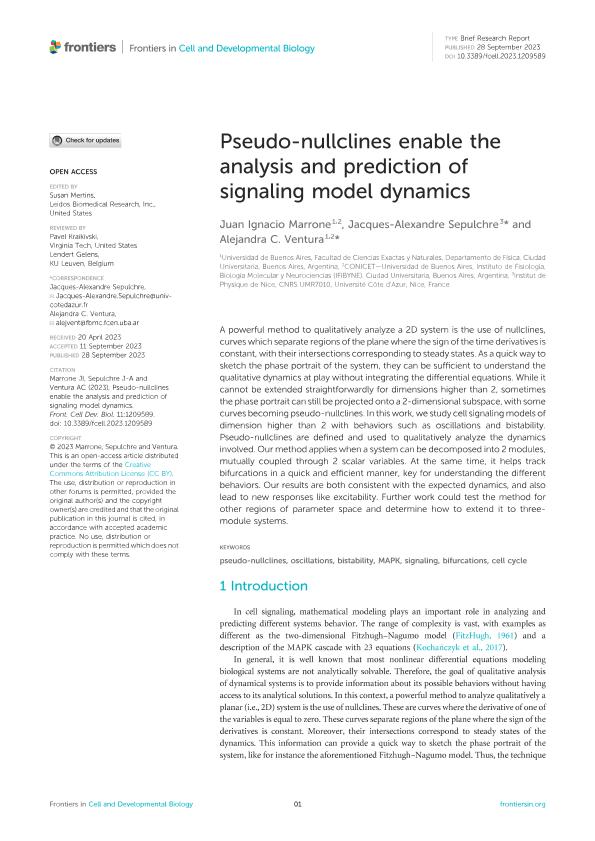Mostrar el registro sencillo del ítem
dc.contributor.author
Marrone, Juan Ignacio

dc.contributor.author
Sepulchre, Jacques Alexandre

dc.contributor.author
Ventura, Alejandra

dc.date.available
2024-04-10T12:38:12Z
dc.date.issued
2023-09
dc.identifier.citation
Marrone, Juan Ignacio; Sepulchre, Jacques Alexandre; Ventura, Alejandra; Pseudo-nullclines enable the analysis and prediction of signaling model dynamics; Frontiers Media; Frontiers in Cell and Developmental Biology; 11; 9-2023; 1-9
dc.identifier.issn
2296-634X
dc.identifier.uri
http://hdl.handle.net/11336/232591
dc.description.abstract
A powerful method to qualitatively analyze a 2D system is the use of nullclines, curves which separate regions of the plane where the sign of the time derivatives is constant, with their intersections corresponding to steady states. As a quick way to sketch the phase portrait of the system, they can be sufficient to understand the qualitative dynamics at play without integrating the differential equations. While it cannot be extended straightforwardly for dimensions higher than 2, sometimes the phase portrait can still be projected onto a 2-dimensional subspace, with some curves becoming pseudo-nullclines. In this work, we study cell signaling models of dimension higher than 2 with behaviors such as oscillations and bistability. Pseudo-nullclines are defined and used to qualitatively analyze the dynamics involved. Our method applies when a system can be decomposed into 2 modules, mutually coupled through 2 scalar variables. At the same time, it helps track bifurcations in a quick and efficient manner, key for understanding the different behaviors. Our results are both consistent with the expected dynamics, and also lead to new responses like excitability. Further work could test the method for other regions of parameter space and determine how to extend it to three-module systems.
dc.format
application/pdf
dc.language.iso
eng
dc.publisher
Frontiers Media

dc.rights
info:eu-repo/semantics/openAccess
dc.rights.uri
https://creativecommons.org/licenses/by-nc-sa/2.5/ar/
dc.subject
Systems Biology
dc.subject
Cell Signaling
dc.subject
Nullclines
dc.subject
Mathematical Model
dc.subject.classification
Otras Ciencias Físicas

dc.subject.classification
Ciencias Físicas

dc.subject.classification
CIENCIAS NATURALES Y EXACTAS

dc.title
Pseudo-nullclines enable the analysis and prediction of signaling model dynamics
dc.type
info:eu-repo/semantics/article
dc.type
info:ar-repo/semantics/artículo
dc.type
info:eu-repo/semantics/publishedVersion
dc.date.updated
2024-04-10T12:05:44Z
dc.journal.volume
11
dc.journal.pagination
1-9
dc.journal.pais
Suiza

dc.description.fil
Fil: Marrone, Juan Ignacio. Consejo Nacional de Investigaciones Científicas y Técnicas. Oficina de Coordinación Administrativa Ciudad Universitaria. Instituto de Fisiología, Biología Molecular y Neurociencias. Universidad de Buenos Aires. Facultad de Ciencias Exactas y Naturales. Instituto de Fisiología, Biología Molecular y Neurociencias; Argentina
dc.description.fil
Fil: Sepulchre, Jacques Alexandre. Centre National de la Recherche Scientifique; Francia
dc.description.fil
Fil: Ventura, Alejandra. Consejo Nacional de Investigaciones Científicas y Técnicas. Oficina de Coordinación Administrativa Ciudad Universitaria. Instituto de Fisiología, Biología Molecular y Neurociencias. Universidad de Buenos Aires. Facultad de Ciencias Exactas y Naturales. Instituto de Fisiología, Biología Molecular y Neurociencias; Argentina
dc.journal.title
Frontiers in Cell and Developmental Biology
dc.relation.alternativeid
info:eu-repo/semantics/altIdentifier/doi/http://dx.doi.org/10.3389/fcell.2023.1209589
Archivos asociados
